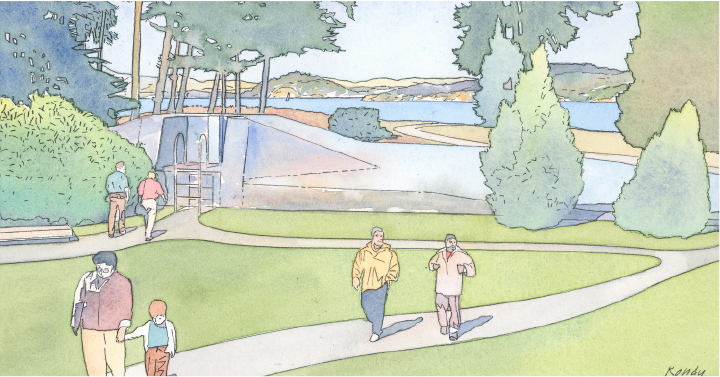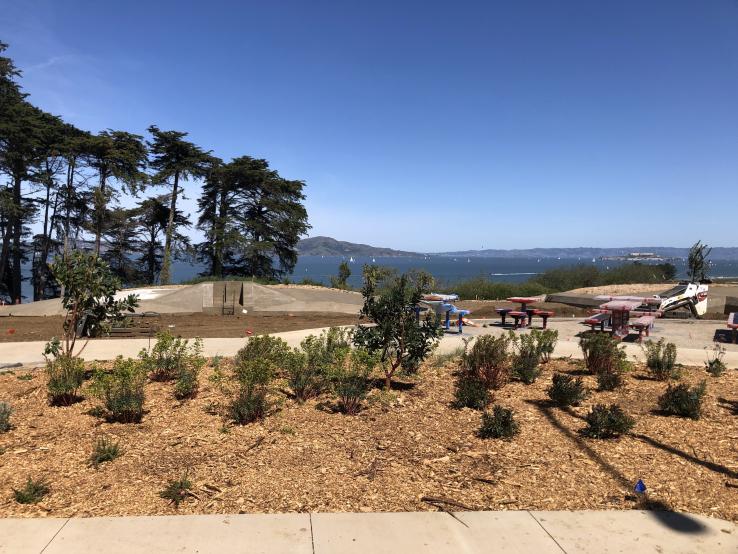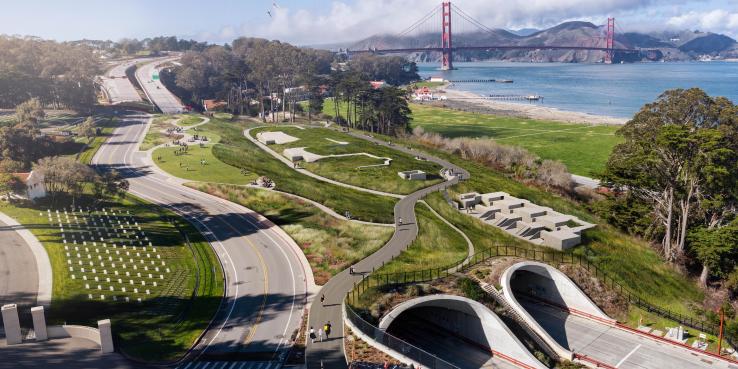This spring, SPUR and San Francisco celebrate the culmination of an extraordinary public project that started 31 years ago: the conception, planning, design and construction of the Presidio Parkway. What began as a safety project to replace a dangerous elevated highway became a community-led process to heal a landscape torn apart by freeway building. This once-in-a-generation project demonstrates SPUR at its most effective: solving tough civic problems through a collaboration of federal, state, regional, city and county agencies; organizing a diverse group of experts; providing a forum for reasonable discussion; and offering long-term continuity on complex, slow-moving urban change.
As our country embarks on what SPUR hopes will be a new era in funding public infrastructure, it’s instructive to examine a project done right.
A Highway Too Dangerous to Ignore
When the Golden Gate Bridge was completed in 1937, Doyle Drive — the skyway connecting the bridge with the street grid of San Francisco — passed over an active military base. As the years passed, Doyle Drive deteriorated structurally and traffic collisions were frequent. The high viaduct was rated the fifth most dangerous bridge in the United States, imperiling more than 100,000 travelers’ lives every day.
Then in 1989, the Loma Prieta Earthquake made clear that the chance of Doyle Drive collapsing was significant, a possibility that was too dangerous to ignore. In 1991 the San Francisco Board of Supervisors established a citizens’ committee called the Doyle Drive Task Force to find a solution. The co-chair of the task force was Michael Alexander, an environmentalist, a member of the GGNRA Advisory Committee and a SPUR board member.
The list of stakeholders in the future of Doyle Drive was unusually long. It started with the San Francisco Board of Supervisors, the San Francisco County Transportation Authority and the State of California, with the California Department for Transportation (Caltrans) holding the ultimate responsibility for maintaining the safety of the freeway, modifying it or building one anew. And then there was the federal government, which owned the land below Doyle Drive. When it was first built, Doyle Drive ran through a military base — soon it would run through the nation’s newest national park. So the National Parks Service was also a stakeholder and, when it formed in 2006, so was the Presidio Trust. Parks advocates, environmentalists, historic preservationists and neighbors all had a stake.
A Vision Emerges: A Plan to Heal the Landscape
This broad constituency came together in committee but had numerous mutually exclusive objectives. There were anti-freeway advocates, neighborhood preservationists, sustainability experts, developer and business interests, park enthusiasts, Golden Gate bridge experts, anti-car and anti-fossil fuel contingencies, lawyers and members of the Sierra Club. It was a classic San Francisco advisory committee. After two years of committee conflict and frustration, a private citizen in the audience, landscape architect and former SPUR board president Michael Painter, emerged with a solution. Instead of focusing solely on how to efficiently move traffic into the city at maximum speed in a minimal distance, he focused on providing a gateway to the city from the Golden Gate Bridge to the Palace of Fine Arts, where Doyle Drive became a city street and the pace of traffic slowed. Painter’s plan highlighted and magnified the existing connection between these two past tributes to technology, the arts and imagination, focusing on the experience of the people moving through the complex topography of the Presidio.
In addition, Painter’s plan connected the open spaces south and north of the parkway — the land and the bay. Indeed, he saw an opportunity for a new Doyle Drive to heal the landscape the old highway had ripped apart when it opened in 1937. His Doyle Drive would fit into the landscape, becoming a part of it rather than perching imperiously above.
And Painter’s road would be a human space, providing views of the park’s landscape to drivers and passengers, while his tunnels — perhaps the most distinctive and surprising element of the plan — would allow picnickers, hikers, photographers and families to walk over the road, from forested hills to San Francisco Bay and back again. It would be a built for the people, in cars or on foot, while honoring a landscape that was becoming as beloved by its current users as it had been sacred to its earliest inhabitants.

Mounting a Challenge to the Freeway Status Quo
Painter’s vision was as practical as it was inspirational. His attention to detail produced a plan that would move large numbers of vehicles both efficiently and safely. Indeed, in the coming decades, Painter’s clarity and vision would guide his work and that of the entire project team, despite being challenged mightily along the way.
“It was the first time that anybody had looked at the project and set it in its context of the headlands of the Golden Gate, the Palace of Fine Arts, and the history of the Presidio, giving respect and recognition to all of these things,” says Michael Alexander.
“This road is all about connectivity, not only for people but for wildlife and the overall ecology,” says landscape architect Michael Boland, the Presidio Trust’s chief park officer. “If Caltrans had proposed a conventional elevated structure or, even worse, a ground-based structure, the public would have been justifiably outraged. So, in a funny way, Michael Painter solved a potentially really big political problem.”
Michael Alexander wrote the task force’s final report, “A Scenic Parkway for the Park,” describing the consensus around the Painter Plan and positioning its key concepts as a guide to a new Doyle Drive. In 1993, the report was unanimously approved by the San Francisco Board of Supervisors.
There was one major problem: Neither Caltrans nor the agency’s lead engineering team supported the task force’s findings. From their points of view, the Painter Plan was not technically feasible. It might look good to a lay audience, and it was certainly beautiful, but it did not meet the technical standards for freeway safety and would be much too expensive to build. The Painter Plan, also known as the “SPUR Alternative,” would become just one of 24 plans under consideration.
The alternatives to the Painter plan were all modern freeways following established guidelines. For example, they all included eight wide lanes, a requirement that made it extremely difficult to meet the 1993 Doyle Drive report’s recommendation to situate the road in the landscape rather than above it.
SPUR leaders became frustrated as the inspirational ideas of the Painter Plan were either set aside or misinterpreted. Enter SPUR members John Eddy and Ignacio Barandiaran, lead transportation planners at Arup, who volunteered their services to evaluate the Painter Plan for SPUR. The two met with Michael Painter to learn the details of his plan.
“Michael Painter just dove right into it,” says Ignacio Barandiaran. Painter unrolled a massive set of hand drawings describing what the key issues were at every hundred-foot segment of the highway. “Every time we asked a question, he either had an answer or would make a note that this was something he needed to go back and develop further. At the end of probably three or four hours of this, we reached the point where everybody kind of stood back and was silent....And we basically said that we loved it…. It was clear to us that this was something that was very visionary and transformative.”
In parallel, a shift was taking place in the management of the Doyle Drive Replacement Project. In consultation with Barbara Kaufman, then chair of the San Francisco Board of Supervisors, Jose Luis Moscovich, executive director of the San Francisco County Transportation Authority, was engaged to represent the SFCTA as Caltrans’s partner on the project. The idea was to give the city an opportunity to develop its own “native solution” for Doyle Drive, and to give Caltrans a collaborator who could effectively navigate the political climate of San Francisco. The SFCTA would be central to the management of the entire project and contribute significant funds to support the new roadway.
To do this, the SFCTA hired Arup to evaluate and verify the plan. Arup’s engineers would spend three solid months diving deeply into the Painter Plan with Michael Painter and his team. Their broad conclusion was not only that the Painter Plan could meet all of Caltrans’ regulations, it would save millions of dollars by reducing the actual construction time required to build the roadway.
Still, it would take four years to sift through the mountain of exceptions to the regulations that were needed for the Painter Plan. “Hundreds of design exceptions were required to make it work from a safety standpoint,” Bijan Sartipi, Caltrans’ then-regional director says, “for both the local community and for Caltrans from a liability standpoint.” And so, as was the case at many moments in this project, the challenges intensified. “You weren’t just talking to the engineers at Caltrans,” Moscovich explains, “but to the lawyers who had to issue some kind of a decision on whether if you built something it would increase, even theoretically, the liability exposure for the state.”
As the project went from concept into detailed design, the SPUR torch passed to a technical committee of activists chaired by attorney Amanda Hoenigman and including engineer Ephraim Hirsch, architect Peter Winkelstein and landscape architect Vera Gates to negotiate hundreds of design exceptions. During this turbulent period, Michael Painter kept his head down, addressing design and technical issues as they came up, with enthusiasm and good will. Incredibly, Painter played this pivotal role without any official title on the project, and he received very little financial compensation for the untold hours he spent on his detailed revisions.
Momentum Builds for the “Parkway for the People”
While the details of the Painter Plan were being negotiated, the Presidio was being developed as one of the first national parks set in an urban area. A new approach to what had once been a freeway-replacement project took hold. The focus was shifting from a freeway for cars to a parkway for the park and the people. The Painter Plan was gaining momentum as a serious alternative for analysis in the upcoming environmental impact report (EIR).
It wasn’t until 2000 that funds were allocated for an EIR evaluating five alternatives. During the review, the Painter Plan, which had initially been written off as too expensive, impractical and nuanced, proved itself to be efficient and practical. As the analysis went deeper, the elegance of Michael Painter’s initial vision showed itself again and again. His idea for Doyle Drive was pretty much as he had said it would be in the beginning. Yes it had been tested, refined and improved along the way, but the fact that so many of Painter’s core recommendations had survived so much scrutiny for so many years was remarkable.
When the final environmental impact report was completed in 2008, the Presidio Parkway was selected as the replacement for Doyle Drive. Significantly, Painter was listed on the first page of the public summary as the architect of the Presidio Parkway.
Through many twists and turns, project funding was assembled by the SFCTA, Caltrans, Speaker Nancy Pelosi and others. In 2008 when the world experienced a financial meltdown, the federal government provided stimulus funding, much of it allocated to “shovel ready” projects. With two decades of planning to show for itself, the project to replace Doyle Drive could not have been more shovel ready.
Battery Bluff, Transformed



Realizing the Dream
Construction began in 2009 — two decades since the 1989 Loma Prieta earthquake had highlighted the dangers of Doyle Drive. When the parkway opened in 2015, the landscaping components of the Painter Plan weren’t yet installed. The shoulders of the roadway were still construction zones, and it was only possible to walk across the tops of the tunnels in one’s imagination. Still, for drivers in 2015, the Presidio Parkway was complete, an amazing accomplishment.
The Doyle Drive Replacement Project had been a long and contentious process, expensive and complex, requiring the collaboration of numerous organizations with very different perspectives and goals. A broad spectrum of citizen groups, most of whom fundamentally disagreed with each other, had participated in a process that pitted dreamers against pragmatists, financial analysts against designers, landscape architects against engineers. The technical complexities of the site were frequently overwhelming, while the requirements designed to ensure safe transit of thousands of people a day gave one pause. And if that had not been enough, the very notion of a freeway running through a national park had often seemed a nonstarter.
And yet, when Presidio Parkway opened, it seemed so natural, one wondered why anything else had ever been considered. Michael Painter’s vision and good will had held it all together, as disparate groups had rallied around a common goal. The individuals who participated in all the debates and struggles were uniformly pleased by what they created. Moreover, they knew that there were lessons from the project that would be valuable to other communities engaged in large and complex infrastructure projects.
The finishing touches to the vision Michael Painter first shared with the Doyle Drive Task Force in 1991, more than 30 years ago, are being completed in 2022. Painter had imagined the tops of his tunnels connecting the land and the bay, “healing this sacred land,” he liked to say. With the landscaping of Battery Bluff, and the Presidio Tunnel Tops –– made possible thanks to more than $100 million in donations from philanthropic individuals, private organizations and foundations — the healing can begin. These new park spaces, as well as the Quartermaster Reach Marsh and landscaping along the periphery of the entire parkway, were only possible because of his design.

In his hand-drawn plans, Michael Painter left the tops of Presidio Parkway’s tunnels as undesigned open spaces. “Michael Painter had this incredibly bold vision,” says the Presidio Trust’s Michael Boland, “but when it got to the Tunnel Tops themselves, his plan simply rendered the areas in green. So, he didn’t take on the role of being the designer of the Tunnel Tops, but he did provide the vision behind their possibilities.”
“Michael Painter’s bold vision for Presidio Parkway not only created the opportunity to stitch the Presidio landscape back together,” says Boland, “It also created the opportunity to build dynamic new park landscapes and deliver long-sought amenities to the Tunnel Tops and Battery Bluff.” Greg Moore, the then-CEO of the Golden Gate National Parks Conservancy adds, “The Tunnel Tops fulfill the magical potential of that location in terms of its scenery, history and nature, taking something that could’ve been ordinary infrastructure and giving it a much greater public benefit.”
The Torch Passes — to All of Us
Michael Painter died in 2018 and didn’t live to see his dream completed. He didn’t get to see groups of friends strolling across the tunnels, or children laughing as they climb play structures, or youth leaders gathering after school in this unparalleled landscape. But he clearly imagined all of these things and would certainly be pleased to know that others understood that completing landscapes like the Battery Bluff and Tunnel Tops was the essential next step after the completion of the Presidio Parkway.
Now it is our turn — to create new experiences in this special place, to develop new rituals around its use, to linger in the hopes of sparking new ideas and understandings, and to think about what we might do to make it both better and more accessible to those who don’t even know yet how much they could love this magical corner of San Francisco. The invitation to community members to enjoy this amazing resource has been sounded. And now they can answer this invitation and make the Presidio and its Parkway their own.
Join us April 25 for a free panel discussion by principal participants in the Parkway process. SPUR members can join an April 28 tour of Battery Bluff. Check spur.org/events for events about Tunnel Tops later this year.
